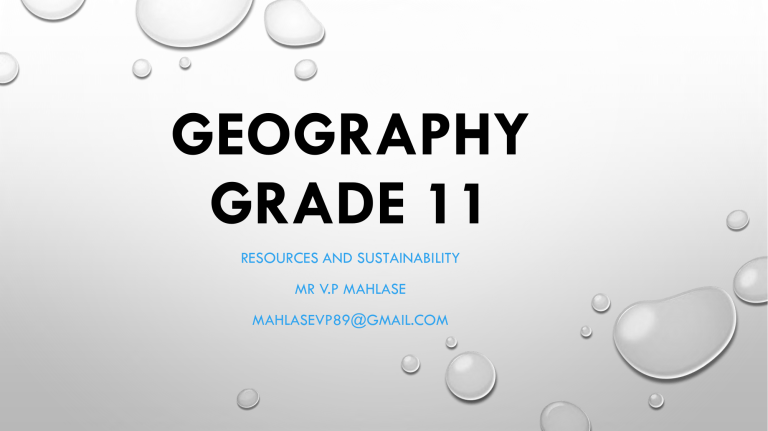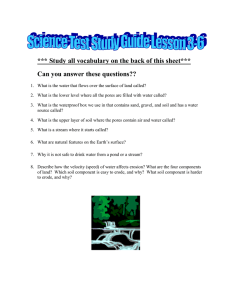
GEOGRAPHY GRADE 11 RESOURCES AND SUSTAINABILITY MR V.P MAHLASE MAHLASEVP89@GMAIL.COM USING RESOURCES THE RELATIONSHIP BETWEEN RESOURCES AND ECONOMIC DEVELOPMENT: • RESOURCES – Things needed and used by people (natural or man made). • HUMAN RESOURCES - Skills, abilities and knowledge that are used for producing goods and providing services. • MANUFACTURED RESOURCES – Items used to produce goods and services. • FINANCIAL RESOURCES – Money needed to process natural resources and pay wages of people who produce goods and services. TYPES OF RESOURCES: RENEWABLE RESOURCES NON-RENEWABLE RESOURCES Man made Natural Quickly and efficiently produced Natures time line to produce Unlimited Limited Can be altered as per requirement Can’t be altered Used for multipurpose Used for specific purpose Not remote to any location Remote to specific locations HOW ARE RESOURCES EXPLOITED AND DEPLETED • EXPLOITATION – Using to the greatest advantage, often fr selfish purposes. • DEPLETION – The use or consumption of a resource, especially natural resources, faster then it is replenished. CAUSES OF RESOURCE DEPLETION: • OVER-CONSUMPTION • INCREASING POPULATION • TECHNOLOGICAL AND INDUSTRIAL DEVELOPMENT • MINING FOR OIL AND MINERALS • FORRESTRY OVER-CONSUMPTION INCREASING POPULATION TECHNOLOGICAL AND INDUSTRIAL DEVELOPMENT MINING FOR OIL AND MINERALS FORESTRY CAUSES OF EXPLOITATION OF NATURAL RESOURCES: DEFORESTATION GREENHOUSE EFFECT SUSTAINABILITY: Meeting the needs of the present without compromising the ability of future generations to meet their own needs. SUSTAINABLE RESOURCE USE NON-SUSTAINABLE RESOURCE USE PEOPLE AND THE ENVIRONMENT Ecotourism, protecting scenery and wildlife. Large-scale tourism, mass inversions at mountains and coastal regions/resorts. PEOPLE AND RESOURCES Re-use, recycle, and reduce, Extensive use of fossil fuels, reforestation, clean unnecessary use of drinking water. minerals, heavy fertiliser and agrichemical use, polluted drinking water. SOCIO-ECONOMIC Controlled urban growth Rapid urbanisation and loss of farmland. SOIL AND SOIL EROSION SOIL – A slowly renewed resource that provides nutrients needed for plant growth and also helps to purify water. HOW IS SOIL FORMED: THE SOIL FORMING FACTORS: • PARENT MATERIAL – SOIL THAT DEVELOPS FROM UNDERLYING ROCK. • RELIEF – THE DIRECTION IN WHICH A SLOPE FACES (NORTH FACING SLOPES RECEIVE MORE SUNLIGHT). • CLIMATE – MOISTURE, TEMPERATURE, AND WIND ARE IMPORTANT CLIMATIC FACTORS THAT INFLUENCE SOIL FORMATION. • ORGANISMS – THE GREATER THE AMOUNT OF VEGETATION GROWING IN THAT SOIL, THE GREATER THE AMOUNT OF ORGANIC MATTER IN THAT SOIL. • TIME – FULLY MATURED SOIL CAN TAKE THOUSANDS OF YEARS TO FORM. SOIL PROFILE: THE PHYSICAL PROPERTIES OF SOIL: SOIL AS A RESOURCE: This is the source of all life on earth. It gets damaged, degraded, temporarily desitificated, but most importantly can be revived. SOIL EROSION: The breaking down and removal of soil. CAUSES OF SOIL EROSION: • WIND EROSION – A lot of wind cause dust and that as a result promotes erosion. • WATER EROSION – Heavy rainfall result in surface run-off and that promotes erosion. • OVERGRAZING – A lot of farmers overstock on livestock and struggling to feed them and therefore become forced to allow them the graze the same place repeatedly. Therefore exposing the land to overgrazing. • PLOUGHING AGAINST THE CONTOUR - Perpendicular to the contour, promotes more surface run-off and makes it easier for rainwater to remove top soil. THE EFFECTS OF SOIL EROSION ON PEOPLE AND THE ENVIRONMENT: • ON-SITE EFFECTS – The reduction in soil quality, as a result from the loss of fertile top soil. Reduction in water carrying capacity. • OFF-SITE EFFECTS – The eroded material may be transported considerable distances. The eroded soil will pollute fresh water sources and cause silt in dams and disrupt ecosystems. WAYS TO PREVENT AND CONTROL SOIL EROSION: • Government control, limiting live stocks. • Educating the public • Controlling veld fires • Contour ploughing • Maintaining good vegetation cover • Fencing paddocks and using rotational grazing CONVENTIONAL ENERGY SOURCES AND THEIR IMPACT ON THE ENVIRONMENT CONVENTIONAL ENERGY SOURCES: • THERMAL – ELECTRICITY PRODUCED FROM COAL (POWER STATIONS), THERE’S ALSO NUCLEAR ENERGY, AND HYDRO-ELECTRICITY. • GEOTHERMAL – THIS IS HEAT FROM THE INTERIOR OF THE EARTH THAT IS USED TO PRODUCE ELECTRICITY (USED BY DEVELOPED COUNTRIES). GENERATING ELECTRICITY FROM COAL COAL WATER TURBINES GENERATOR TRANSFORMERS ADVANTAGES: DISADVANTAGES: • S.A has a lot of coal. • High rates of pollution. • Coal-fired power is reliable. • Building a coal powered station is expensive and takes long. • Good infrastructure • Abundant labour • Coal powered stations are raw resource orientated. • Requires heavy maintenance. LONG AND SHORT TERM IMPACTS POSITIVE: NEGATIVE: • Provides stable jobs. • Destroys the environment. • Reliable energy source. • Future generations need an alternative source. • Produces large supplies of power. • Disturbs ecosystems. • Abundant coal reserves. • Promotes environmental degradation. NON-CONVECTIONAL ENERGY SOURCES SOLAR ENERGY: WIND ENERGY: ENERGY MANAGEMENT IN SOUTH AFRICA • LOAD SHEDDING – Selective power cuts, when demands exceeds generating capacity. ENERGY MANAGEMENT: • Carbon footprint – a measure of the impact our activities have on the environment and climate change. • Greener economies – is one that is low carbon and has efficient use of resources. • Sustainability – lifestyle that attempts to reduce your use of the earth’s natural resources. NB: IT IS THE RESPONSIBILITY OF THE GOVERNMENT, BUSINESSES AND INDIVIDUALS TO UPHOLD THESE INITIATIVES. THANK YOU!

